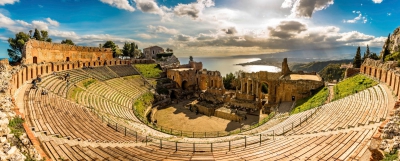The Muslim conquest of Sicily began in June 827 and lasted until 902, when the last major Byzantine stronghold on the island, Taormina, fell. Isolated fortresses remained in Byzantine hands until 965, but the island was henceforth under Muslim rule until conquered in turn by the Normans in the 11th century.
Although Sicily had been raided by the Muslims since the mid-7th century, these raids did not threaten Byzantine control over the island, which remained a largely peaceful backwater. The opportunity for the Aghlabid emirs of Ifriqiya came in 827, when the commander of the island's fleet, Euphemius, rose in revolt against the Byzantine Emperor Michael II. Defeated by loyalist forces and driven from the island, Euphemius sought the aid of the Aghlabids. The latter regarded this as an opportunity for expansion and for diverting the energies of their own fractious military establishment and alleviating the criticism of the Islamic scholars by championing jihad, and dispatched an army to aid him. Following the Arab landing on the island, Euphemius was quickly sidelined. An initial assault on the island's capital, Syracuse, failed, but the Muslims were able to weather the subsequent Byzantine counter-attack and hold on to a few fortresses. With the aid of reinforcements from Ifriqiya and al-Andalus, in 831 they took Palermo, which became the capital of the new Muslim province.
The Byzantine government sent a few expeditions to aid the locals against the Muslims, but preoccupied with the struggle against the Abbasids on their eastern frontier and with the Cretan Saracens in the Aegean Sea, it was unable to mount a sustained effort to drive back the Muslims, who over the next three decades raided Byzantine possessions almost unopposed. The strong fortress of Enna in the centre of the island was the main Byzantine bulwark against Muslim expansion, until its capture in 859. Following its fall, the Muslims increased their pressure against the eastern parts of the island, and, after a long siege, captured Syracuse in 878. The Byzantines retained control of some fortresses in the north-eastern corner of the island for some decades thereafter, and launched a number of efforts to recover the island until well into the 11th century, but were unable to seriously challenge Muslim control over Sicily. The fall of the last major Byzantine fortress, Taormina, in 902, is held to mark the completion of the Muslim conquest of Sicily.
Under Muslim rule, Sicily prospered and eventually detached itself from Ifriqiya to form a semi-independent emirate. The island's Muslim community survived the Norman conquest in the 1060s and even prospered under the Norman kings, giving birth to a unique cultural mix, until it was deported to Lucera in the 1220s after a failed uprising.
Taormina (UK: TAH-or-MEE-nə, US: -nah, also , Italian: [ta.orˈmiːna]; Sicilian: Taurmina; Maltese: Tormina; Latin: Tauromenium; Ancient Greek: Ταυρομένιον, romanized: Tauroménion) is a comune (municipality) in the Metropolitan City of Messina, on the east coast of the island of Sicily, Italy. Taormina has been a tourist destination since the 19th century. Its beaches on the Ionian sea, including that of Isola Bella, are accessible via an aerial tramway built in 1992, and via highways from Messina in the north and Catania in the south. On 26–27 May 2017 Taormina hosted the 43rd G7 summit.

 English
English  español
español  français
français  português
português  русский
русский  العربية
العربية  简体中文
简体中文 
